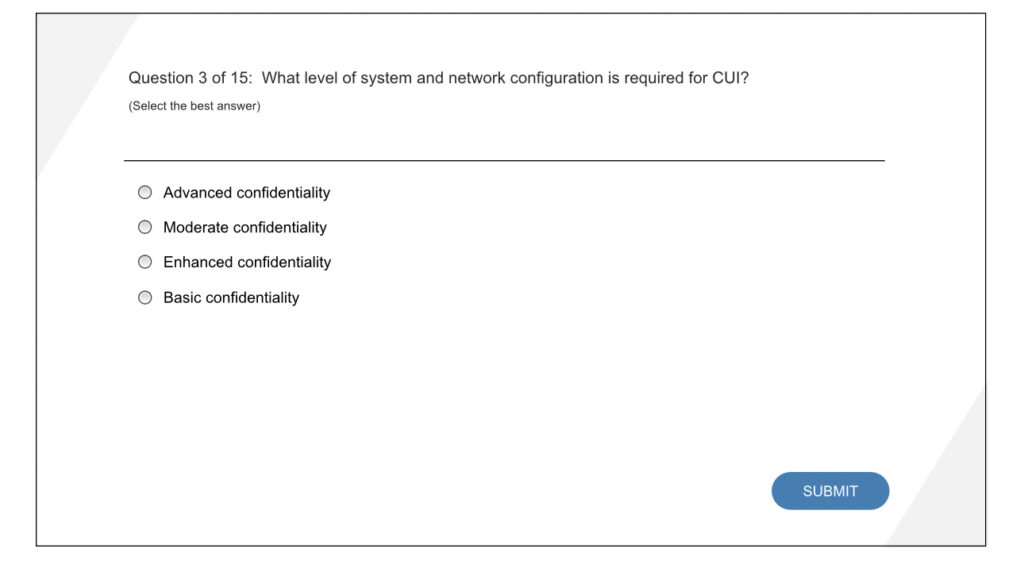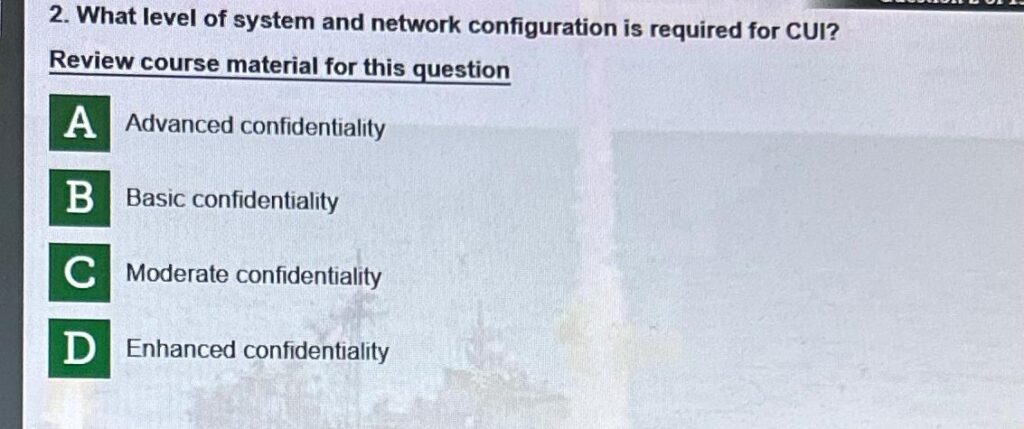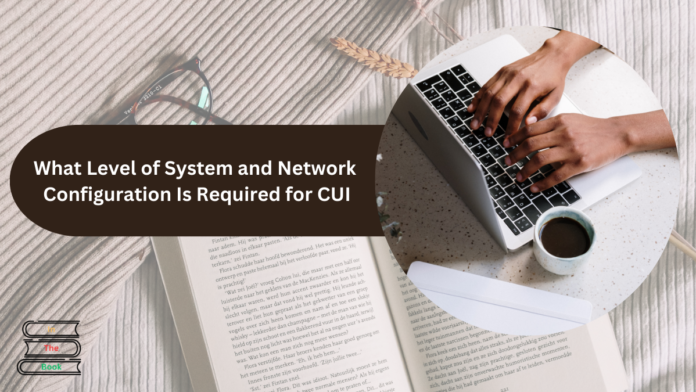Table of Contents
What level of system and network configuration is required for CUI? Controlled Unclassified Information (CUI) is sensitive information that needs protection, but it isn’t classified. Ensuring the security of CUI involves setting up the right system and network configurations to keep the data safe from breaches and to meet government standards.
To protect CUI, organizations must implement specific security measures, such as encrypting data, limiting access, and using firewalls. These configurations help maintain the confidentiality and integrity of the information, which is crucial for both security and legal reasons. By setting up these systems, companies can make sure their CUI is protected and compliant with rules like NIST SP 800-171.
What Level of System and Network Configuration is Required for CUI? A Simple Guide
When it comes to what level of system and network configuration is required for CUI, it’s important to understand that securing sensitive information involves a mix of strong systems and network setups. Organizations must take specific steps to protect Controlled Unclassified Information (CUI) to avoid breaches and meet regulatory standards. Without these configurations, organizations risk data theft and loss, which can lead to serious consequences.
The key system-level configurations focus on controlling access to CUI. Limiting access to authorized individuals only is a major part of securing this type of information. By using technologies like Multi-Factor Authentication (MFA) and Role-Based Access Control (RBAC), businesses can ensure only the right people have access. Implementing these tools reduces the risk of unauthorized access.

Key System Configurations for Protecting CUI: What You Need to Know
The level of system configuration required for CUI protection starts with encryption. What level of system and network configuration is required for CUI? To ensure that the data is safe, encryption both at rest and in transit is crucial. Encrypting data helps prevent unauthorized users from reading or tampering with sensitive information. Using strong encryption standards like AES-256 ensures that even if data is intercepted, it remains unreadable without the correct key.
Next, organizations should ensure their systems are regularly updated and patched. This helps eliminate vulnerabilities that could be exploited by hackers. Regular updates and applying security patches are essential to reducing risks and maintaining compliance with standards like NIST SP 800-171.
How Access Control Helps in Securing CUI: Essential Steps
Access control is one of the most important security measures for protecting CUI. Proper access control ensures that only authorized individuals can interact with sensitive information. The first step is implementing Role-Based Access Control (RBAC), where users only have access to the data necessary for their job roles.
In addition to RBAC, Multi-Factor Authentication (MFA) is an effective method of verifying identity. MFA requires users to provide more than one form of identification, such as a password and a fingerprint scan. This extra layer of protection significantly decreases the chance of unauthorized access.
Subheading: Importance of MFA and RBAC in CUI Protection
- RBAC limits access based on job roles, reducing exposure.
- MFA adds an extra layer of security to confirm identity.
- Both help prevent unauthorized access to CUI.
Why Data Encryption is Crucial for CUI Protection
Encryption is one of the most effective ways to protect what level of system and network configuration is required for CUI. By encrypting sensitive data, businesses can ensure that even if the data is intercepted, it cannot be read or used. AES-256 is commonly used to encrypt data, and it’s one of the most secure encryption standards available today.
Encryption should not only apply to stored data but also to data in transit. Transport Layer Security (TLS) should be used to encrypt data as it moves across networks. This ensures that data remains safe and secure during communication between systems.
Understanding Logging and Monitoring in CUI Security
Logging and monitoring systems help businesses keep track of all activities involving CUI. It’s important to maintain detailed logs of who accesses the data, when, and what changes they make. Logs are a critical part of detecting unusual or unauthorized activity.
Organizations should use tools like Security Information and Event Management (SIEM) to aggregate and analyze these logs. This allows for real-time monitoring, which can help detect potential security breaches early and take action before any damage is done.
System Hardening for CUI: Reducing Vulnerabilities in Your Setup
System hardening refers to the process of reducing the potential weaknesses in systems that handle CUI. It involves disabling unnecessary services and closing unused ports, which limits the opportunities for attackers to exploit vulnerabilities. Regularly updating security patches is another important part of system hardening.
Furthermore, organizations should implement endpoint protection solutions to detect and block malware. This helps reduce the chances of malware infiltrating systems and compromising sensitive data.
Network-Level Configuration Requirements: What You Should Do to Secure CUI
To protect CUI at the network level, organizations must implement certain measures. Firewalls are essential for controlling both inbound and outbound traffic to and from the network. Properly configuring these firewalls helps filter malicious traffic and prevent unauthorized access.
In addition, segmentation is a valuable strategy for isolating networks that handle CUI from those used for general purposes. This reduces the chances of a hacker moving laterally across the network if one part of the system is compromised.
Subheading: Key Network Protection Measures
- Firewalls control and filter network traffic to prevent unauthorized access.
- Network segmentation isolates sensitive data to reduce risk.
- Regular updates ensure firewalls and systems remain secure.
How VPNs Keep CUI Safe from Unauthorized Access
VPNs (Virtual Private Networks) are crucial for securing remote access to CUI. They create a secure, encrypted connection between employees and the organization’s network, ensuring that data remains private even when accessed from outside the office.
Organizations should require all remote workers to use a VPN when accessing sensitive data. Monitoring VPN usage helps detect unauthorized connections and provides an additional layer of security.
How Intrusion Detection and Prevention Systems (IDPS) Help Secure CUI
Intrusion Detection and Prevention Systems (IDPS) are essential tools for detecting and stopping security threats in real time. These systems monitor network traffic and system activities to identify any abnormal or malicious behavior that could indicate a breach.
Using both signature-based detection for known threats and behavior-based detection for unknown threats helps protect sensitive data. Regularly updating IDPS signatures ensures that these systems remain effective against new types of attacks.
Ensuring Compliance with NIST SP 800-171 for CUI Protection
Compliance with NIST SP 800-171 is a critical part of ensuring the protection of CUI. This set of guidelines outlines specific security controls that organizations must implement to safeguard sensitive data. Following these guidelines helps organizations meet federal requirements for handling CUI.
Key configurations include access control, encryption, and monitoring, all of which are essential for maintaining compliance. Regular audits and assessments ensure that organizations continue to meet these security standards.
Practical Tips for Configuring Your System to Safeguard CUI
To simplify the process of configuring systems for CUI protection, organizations should conduct regular gap analyses to identify areas for improvement. Automating configuration management with tools like Configuration Management Databases (CMDBs) can help streamline the process and ensure compliance.
Regular security audits and employee training are also essential for maintaining a secure environment. Engaging cybersecurity experts ensures that configurations are correctly implemented and kept up to date.

Conclusion
In conclusion, what level of system and network configuration is required for CUI is significant for ensuring the protection of sensitive data. By implementing key configurations like encryption, access control, and regular system updates, organizations can safeguard their CUI and meet compliance standards.
These configurations help prevent data breaches, maintain confidentiality, and ensure that businesses operate smoothly without security interruptions. Ensuring that CUI is properly protected builds trust with clients and partners, which is essential for long-term success.
FAQs
Q: What is CUI?
A: CUI stands for Controlled Unclassified Information. It is sensitive data that requires protection but isn’t classified.
Q: Why is encryption important for CUI?
A: Encryption protects CUI by making it unreadable to unauthorized users, even if they intercept the data.
Q: How does access control help protect CUI?
A: Access control limits who can access CUI, ensuring only authorized users can see or modify the data.
Q: What is a firewall, and why is it needed for CUI?
A: A firewall filters network traffic to prevent unauthorized access, helping protect CUI from external threats.

